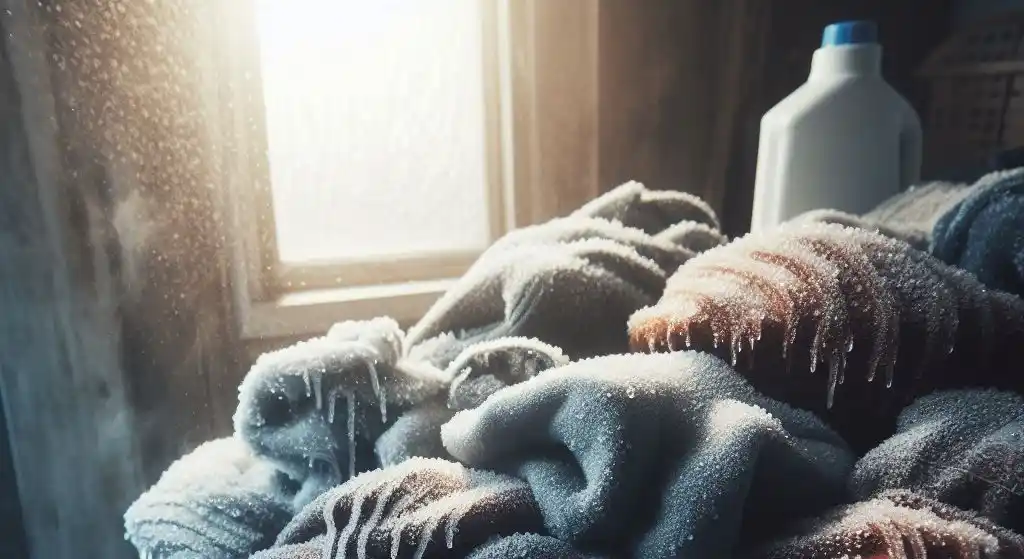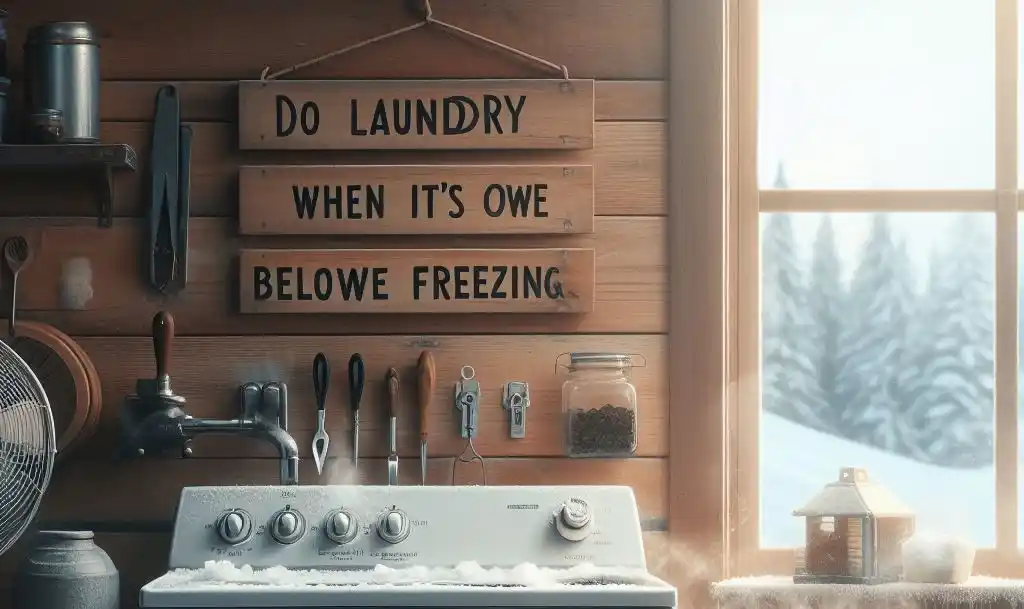Is It Safe to Do Laundry When It’s Below Freezing? Laundry in Extreme Cold Weather
Doing laundry when it’s below freezing outside can seem daunting. Extreme cold weather brings unique challenges that may have you wondering if running your washing machine is safe when temperatures plummet.
The good news is that it is generally safe to do laundry even when it’s freezing outside. However, there are some precautions you should take and factors to consider first before tossing in a load when it’s cold. Keep reading to learn tips for safely doing laundry during winter’s freezing temps.
In this comprehensive guide, we will explore whether is it safe to do laundry when it’s below freezing and many related aspects of doing laundry in freezing winter.
Table of Contents
How Cold Temperatures Affect Your Washing Machine
Freezing temperatures can impact your washing machine in a few key ways:
- Frozen pipes/hoses – The water lines and hoses connected to your washer can freeze in frigid weather. This stops water flow completely, preventing the machine from filling and operating.
- Winter temperatures can cause the water intake valve to freeze, leading to damaged water valves and potential malfunction of home appliances. – In extremely cold weather, the water intake valves on washers can become brittle and crack under pressure when turning the water on or off. This causes leaks and water damage.
- Circulation issues – Your machine may not spin or drain properly if water sitting inside components or hoses freezes. The frost buildup blocks proper circulation and can cause water everywhere if not addressed.
Many modern washers are designed to handle some cold exposure. However, in sub-zero temperatures, the risk of freezing and malfunction increases. We’ll discuss proper precautions shortly.
Where to Locate Your Washer in Winter

Ideally, your washing machine should be located indoors if temperatures will drop below freezing. Garages and basements are risky spots for laundry appliances during extreme cold due to a lack of insulation and greater exposure to freezing drafts.
Even when housed inside, choose an interior room on your main level for doing laundry in winter. Rooms on exterior walls tend to be chillier.
Other Tips for Washer Placement When Freezing:
- Avoid placing near drafty windows or doors leading outside
- Close doors to the laundry room to retain heat
- Ensure good airflow around the washing machine so operational vibration doesn’t cause it to wiggle up against cold exterior walls. Leave a few inches of clearance.
- Consider adding an interior wall insulation for more protection and sound buffering
If locating your machine indoors isn’t possible, we’ll cover some garage and basement set-up tips later for keeping washers safely running.
Protecting Water Lines from Freezing
Frozen hoses and pipes are one of the biggest laundry risks during below-freezing weather. When water inside supply lines freezes and expands, extreme pressure builds up. This can burst pipes and damage valves.
Here are some tips to prevent frozen water lines affecting washing machines when doing laundry in winter:
- Insulate hose connections at the washer inlet valve with detachable foam pipe insulation sleeves. Secure them tightly in place with duct tape, zip ties or insulation hose clamps.
- For machines in basements or garages, wrap exposed water supply pipes and drains with special heat tape made for plumbing.
- Shut off water to the laundry room and drain any remaining water from pipes when not actively using the washer. This minimizes standing water inside hoses or valves that could freeze.
- For units like the ice maker, located against exterior walls, it’s crucial to install proper insulation. permanent insulating wall panels behind the machine to block freezing air.
- In extremely cold climates, consider replacing rubber washing machine hoses with burst-resistant braided stainless steel supply lines. Home appliances with their durable construction make them less prone to winter damage.
Taking preventative steps to guard pipes from freezing can affect your appliances like your washer, allowing it to function smoothly even when temperatures are frigid outside.
Adjusting Water Temperature Settings
Laundry cycles require certain water temperatures for optimal performance. However, some adjustments of your machine’s water thermostat may be beneficial in winter to reduce the risk of ice buildup.
Lowering the temperature settings on hot and warm cycles gives pipes feeding the unit less drastic cold-to-hot fluctuations. This lessens the likelihood of freeze-thaw cycles forming ice crystals internally.
Avoid extremely hot washes during sub-zero external conditions. The wide swing from hot interior water back down to freezing during machine drainage stresses plumbing.
Of course, colder washes may reduce cleaning efficacy and increase energy usage. Find the right balance for your climate and winter laundry needs.
Now let’s talk about some extra safeguards if the only option is keeping your washer in the garage or basement when it’s cold out.
Doing Laundry in Freezing Temperatures: Garage Setup

Garages provide convenient laundry spaces but require additional winterizing during extreme cold due to minimal insulation from outside elements. Here are some tips:
- Maintain above-freezing interior garage temps Ensure your appliances function smoothly in freezing weather with a networked hardwired heating unit, a space heater or even an infrared quartz electric portable heater.
- Insulate water lines, and address air gaps around doors and walls.
- If the washer is against exterior walls, construct temporary insulating barricades to block drafts. Use rigid foam boards sealed in place with caulk/construction adhesive for the best effect.
- Position the unit near interior firewalls leading into a main home rather than outer garage walls.
- Install home appliances with adequate insulation to combat winter temperatures. heavy insulating blankets specifically made for laundry machines to provide an extra buffer around the body and water connections. Secure with ties to prevent dislodging.
- Consider enclosing the washer area with temporary partitions to create a tighter, warmer laundry closet. Use rigid insulation panels and seal edges to the floor using foam board or silicone caulk to prevent cold air intrusion.
- Only run the appliance when the garage is warm enough to prevent frozen pipes/hoses. Operate portable heaters for a minimum of 4-6 hours before doing laundry in freezing conditions. Monitor conditions diligently during cold winter to ensure water doesn’t freeze in your household appliances.
Safely Using Washers in Unheated Basements When Freezing
Like garages, venturing downstairs to an uninsulated basement laundry room in winter takes additional precautions:
- If possible, enclose the area with temporary or permanent floor-to-ceiling partitions using moisture-resistant drywall, paneling or rigid insulation boards. This helps trap rising heat from the active dryer rather than it dissipating into the larger basement space. Foam insulation with vapor barriers works especially well.
- To protect your home appliances, wrap water pipes feeding the machine with electric heat tape or detachable foam covers secured in place, especially when the temperature drops below freezing.
- Use a portable 1500+ watt electric space heater and run continuously for at least 2-3 hours before doing laundry to warm the room and appliance. Position safely away from contact with the machine or dryer using a tip-resistant base.
- For unfinished basements, seal any cracks or exterior wall/ceiling air gaps with silicone caulk and foam backer rods to prevent drafts from infiltrating the enclosed laundry area.
- Only operate equipment once temperatures stabilize above freezing in the enclosed room. Monitor conditions closely rather than leaving them unattended for long periods.
- Consider adding ** basement wall and ceiling insulation** for frequently used appliances like washers. This provides better protection from freezing basement drafts.
Handling Power Loss When Freezing
A complete loss of power and heating poses another winter laundry dilemma – how to safely drain washing machines with no functioning drainage pump when temperatures dip below freezing.
Here are smart steps for emergency drainage when power fails in freezing weather:
- Rush to the machine as soon as an outage occurs before substantial ice forms – don’t allow water sitting inside to completely freeze. Time is critical to drain the water from household appliances in freezing weather.
- If winter temperatures cause the water intake valve to freeze, manually siphon outwash/rinse water using a hand pump, scoop or wet/dry vac designed for pumping water.
- If ice buildup inside the drum or hoses blocks drainage, use safe heat application from a hair dryer, space heater or heated towels atop the frozen components to gently melt the ice blockage. Monitor the area closely and avoid electrical hazards.
- Once power and heat return, run a full wash cycle at the highest temperature setting to flush residual water/ice from internal compartments.
Prevention is ideal, but having an emergency action plan allows the safe handling of cold-weather laundry issues during severe winter events and related outages.
Adjusting Detergent Use When Freezing
Frigid temperatures impact more than just washing machine function – they can also influence laundry detergent cleaning effects. The viscosity of some soap products increases in very cold conditions. Cool water also limits the solubility and chemical activity of cleaners.
Here are some tips for improving results when washing in winter:
- Use powdered detergents formulated for cold water rather than thicker liquid gels that solidify easily.
- Boost cleaner concentration for cold washes – start with about 20-25 percent more detergent than package directions specify.
- Allow extra soak time for chilled water to fully penetrate fabrics – stop the cycle 10-15 minutes in to let soap dissolve and permeate materials.
- If washing in very hard water, add water-softening agents like borax to counteract reduced sudsing.
- whitening boosters help compensate for cooler temperatures minimizing bleaching agent performance.
- Avoid cramming extra layers into loads When doing your laundry in cold conditions, use detergents with lighter density as it allows better cleaning mechanics.
Adjusting wash routines and products for winter can help achieve the usual standard of cleaning despite the cold temperatures.
Preventing Damage from Water Issues
In addition to hindering washing machine function, frozen water causes immense damage if it thaws or breaks free unexpectedly. Pipes bursting from ice expansion is bad enough, but water leakage onto electrical systems or unchecked mold growth creates further destruction.
Here are some damage control measures to experiment with those weather affect your home: when tackling laundry in sub-zero conditions.
- Store an emergency water sensor alarm near the machine to detect leakage issues promptly before flooding occurs. Many connect via wifi to send mobile alerts.
- For units on concrete basement slabs or garages, place washers atop shallow catch pans able to hold several gallons of water. Raise machines on bricks inside the lined pans allowing overflow drainage.
- In case of hose failure, install automatic shutoff valves to cut water supply and minimize flooding. Connect them to motorized leak detectors for the quickest response.
- Learn how to quickly shut off central water distribution and electrical systems so you can respond correctly. Store any special tools needed nearby.
- After lengthy power losses, thoroughly check for and repair any weather-related damage before restoring laundry operations.
Maintaining Indoor Livability
Laundry isn’t the only system struggling during bitter cold spells; the freezing weather can drastically affect other household appliances too. Heating and HVAC equipment work overtime, yet freezing drafts still creep into a home. Structural damage occurs if indoor temperatures drop too low.
Here are tips for maintaining safe interior conditions:
- Monitor your furnace runtimes and call professionals immediately if units run continuously without maintaining thermostat set temps. Failures often increase during severe cold. Arrange emergency HVAC service plans in advance.
- Prevent ice dams on roofs by keeping attics well insulated and properly ventilated. Clear snow off roofs frequently using roof rakes.
- Check home insulation levels in walls, attics, and crawl spaces. Adding insulation reduces winter heat loss and lowers utilities.
- Install tight-fitting insulating draft guards beneath exterior doors and beef up weather stripping around windows. Close off unused rooms and vents.
- Let faucets drip during extreme cold to keep water flowing through pipes for households with inadequate insulation in walls.
- For homes at high risk of freeze damage, consider installing full-home emergency heat sources like hydronic radiators or electric resistance units with gas generators as backup. Though expensive, investing in reliable heating equipment for your home appliances can save your home should heating equipment fail during long periods of winter temperatures.
Maintaining interior warmth is challenging in extreme cold but critical for safe laundry operations and preventing extensive home damage. Added winterization projects make homes more resistant to low temperatures.
Doing Laundry Offsite During Deep Freezes
For households with high-risk conditions, relocating laundry to an offsite warmer location may warrant consideration during bitter cold spells. Here are options to explore:
- Visit a friend or family member’s house outside your area not impacted by the weather extremes. Offer to exchange use of appliances or assist with their laundry.
- Rent machines at a nearby laundromat. Though inconvenient, it removes safety issues plus hauling icy clothes back and forth lets vehicles warm too!
- See if your workplace, gym, dorm or apartment complex offers public use laundry facilities you can utilize in the interim. Offer a small donation toward water/electric costs.
- Inquire about availability to use laundry at rental cabins, hotels, shelters, truck stops, campgrounds, or marinas. Most locations welcome small intermittent community use for nominal fees.
- Head south and turn the arctic outbreak into a small laundry-focused road trip! Reach out to warmer regions’ tourism boards for unique yet economical laundering locales.
While finding alternative locations requires effort, it beats canceling plans or events due to unavailable clean clothes. Worn items also last longer between deeper cleanings.
Emergency Measures for Laundry Needs
Despite your best preparations, a stretch of record lows combined with equipment failure can leave anyone temporarily stuck without laundry abilities. Before resorting to drastic measures:
- Contact local charities, civic groups, churches, and community centers to request access to laundry assistance programs if machines are inoperable for the underserved.
- Use social networks to arrange clothing exchanges with family/friends close in size. Expand groups to maximize variety in dealing with ice instead of water in your appliances. Host swap events to supplement wardrobes, particularly during lower temperature drops below freezing.
- Stores often sell travel-sized laundry soaps for washing items manually. Try hand-washing favorite garments in tubs using gentle cleansers, then air drying throughout the home.
- Invest in apparel fabrics bolstered with antimicrobial technology such as silver ions that resist developing odors and bacteria between full cleanings in cold winter.
- Sew small squares of ultra-absorbent shammy fabric inside sweat-prone clothing areas like armpits to help absorb moisture and body oils between wearings.
While not long-term fixes, emergency plans help bridge the situation until laundry gets back on track.
Improvising Indoor Drying Options
Laundry isn’t finished until clothes get dried. Icy weather causes hanging drying garments indoors to take longer, making people do laundry less frequently. Accelerate the process with these clever tips:
- Arrange collapsible drying racks near heating vents when doing laundry in cold, to utilize rising warm airflow. Use gravity by placing racks on top of low furniture, not floor level.
- For households already using humidifiers, move the equipment near drying setups. The excess moisture aids evaporation despite cooler indoor temps.
- Position household floor fans nearby to simulate the breeze. Angle them upward slightly to push rising heat toward clothing.
- Microwave uncooked rice, salt, or silica sand-filled socks for 60-90 seconds then scatter them still warm between clothing piles. The residual heat is released over hours.
- Fill sealable plastic storage bins with laundry, then place the enclosed containers atop room radiators, low fireplaces, or other ambient low-level heat sources.
While challenging, with clever adaptations heavy winter laundry needs can get fully dried without reliance on gas or electric dryers in a pinch.
Preventing Ice Dams Around HVAC Units
With homes running heating systems over time during Arctic blasts, frozen gutters and roofline ice dams constantly threaten equipment. Increasing outdoor condenser units or air intake vents halts air flow and strains systems. Here is guidance regarding HVAC winter care:
- Install gutter heat cables specially made to handle heavy ice and snow loading to keep roof edges clear. Products meet strict exterior building codes.
- Use long poles or rakes to frequently pull snow loads away from roof edges where ice dams form over gutters and valleys. Don’t allow deep buildup.
- Shovel wide paths around HVAC units and air exchange ports along home foundations or exterior walls. Fully clear condensed drifts and windrows of snow blocking intake airflow.
- Inspect conduits between indoor handling equipment and outdoor compressors for good insulation levels. Ensure no gaps or tears allow cold air leakage to impact system functionality.
- Listen for labored HVAC fans and contact specialists promptly for maintenance. Winter strain can cause fast wear on parts like fan belts. Replace them preventatively.
- Register all HVAC appliances for faster emergency repair dispatch during extreme weather events through providers’ home protection plans.
Proper winter HVAC care reduces costly seasonal repairs and keeps households more comfortable despite subzero temperatures outside persisting for laundry duty!
Conclusion: is it safe to do laundry when it’s below freezing
Frigid winter weather undoubtedly increases daunting challenges regarding home laundry operations. Frozen water pipes, struggling washing machines, and inadequate drying conditions test one’s resolve to get the job done.
Yet with decisive preparation directed at insulating water lines, adjusting appliance settings, emergency planning, and implementing damage control measures, satisfactory outcomes prevail. Also, build flexible adaptations into winter laundry routines.
The key in freezing weather is respecting the threats cold brings, without forfeiting lifestyle needs or quality standards. Invest properly in protective equipment like insulation while also embracing creative workarounds during weather-imposed compromises.
Stay encouraged through proper planning, helpful technology like modern home appliances, and community resources as well. If dire enough, even brief relocation uptakes the slack until the icy grip of winter releases into the welcome spring thaw.
Laundry in Freezing Cold FAQs
Is it safe to allow laundry water pipes to freeze?
Not. Frozen water quickly expands inside confined pipes and pressure builds until catastrophic rupture and flooding. Always insulate lines properly and run indoor heaters to maintain above-freezing temps around appliances.
Which is better for winter laundry – liquid or powder detergent?
Powdered detergents dissolve and clean better in cold water. Liquid gels thicken in cold temps and lose cleaning power unless boosted with more soap. Stick with powders like Tide Coldwater Clean.
Should I drain washing machines between use in winter?
Yes, draining all water from hoses and internal compartments is wise to minimize standing water that can freeze and cause ice blockages. Be sure to reconnect and refill hoses per manufacturer instructions before subsequent uses.
Is it okay to wash laundry if it’s below zero degrees outside?
Yes, but take proper precautions! Protect water lines from freezing, locate machines in interior rooms not alongside outside walls, adjust water temperatures accordingly, and follow other winter-specific guidelines covered above for best results and safety.
What’s the lowest safe temperature for running a washing machine?
Most can operate down to just above freezing temperature levels of 35-40°F assuming proper precautions are followed. Check your user manual for the minimum ambient operating range before attempting winter use during extreme cold.
The key to tackling laundry despite below-freezing external temperatures








